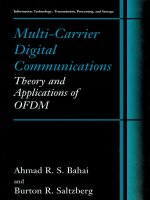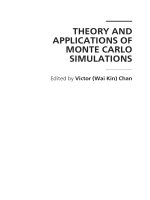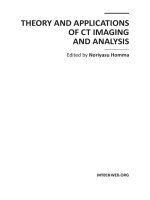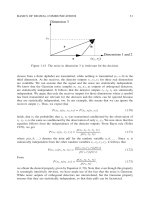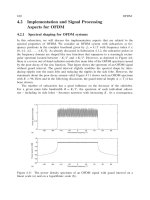Multi-Carrier Digital Communications Theory and Applications of OFDM pdf
Bạn đang xem bản rút gọn của tài liệu. Xem và tải ngay bản đầy đủ của tài liệu tại đây (4.97 MB, 221 trang )
Multi-Carrier
Digital Communications
Theory and Applications of OFDM
Information Technology: Transmission, Processing, and Storage
Series Editor: Jack Keil Wolf
University of California at San Diego
La Jolla, California
Editorial Board: James E. Mazo
Bell Laboratories, Lucent Technologies
Murray Hill, New Jersey
John Proakis
Northeastern University
Boston, Massachusetts
William H. Tranter
Virginia Polytechnic Institute and State University
Blacksburg, Virginia
Multi-Carrier Digital Communications: Theory and Applications of OFDM
Ahmad R. S. Bahai and Burton R. Saltzberg
Principles of Digital Transmission: With Wireless Applications
Sergio Benedetto and Ezio Biglieri
Simulation of Communication Systems, 2nd Edition: Methodology, Modeling,
and Techniques
Michel C. Jeruchim, Philip Balaban, and K. Sam Shanmugan
A Continuation Order Plan is available for this series. A continuation order will bring delivery of each new volume
immediately upon publication. Volumes are billed only upon actual shipment. For further information please contact
the publisher.
Multi-Carrier
Digital Communications
Theory and Applications of OFDM
Ahmad R. S. Bahai and
Burton R. Saltzberg
Algorex, Inc.
Iselin, New Jersey
Kluwer Academic Publishers
New York, Boston, Dordrecht, London, Moscow
eBook ISBN: 0-306-46974-X
Print ISBN: 0-306-46296-6
©2002 Kluwer Academic Publishers
New York, Boston, Dordrecht, London, Moscow
Print ©1999 Kluwer Academic / Plenum Publishers
New York
All rights reserved
No part of this eBook may be reproduced or transmitted in any form or by any means, electronic,
mechanical, recording, or otherwise, without written consent from the Publisher
Created in the United States of America
Visit Kluwer Online at:
and Kluwer's eBookstore at:
Preface
Multi-carrier modulation, in particular Orthogonal Frequency Division
Multiplexing (OFDM), has been successfully applied to a wide variety of
digital communications applications over the past several years. Although
OFDM has been chosen as the physical layer standard for a diversity of
important systems, the theory, algorithms, and implementation techniques
remain subjects of current interest. This is clear from the high volume of
papers appearing in technical journals and conferences.
This book is intended to be a concise summary of the present state of the
art of the theory and practice of OFDM technology. The authors believe that
the time is ripe for such a treatment. Particularly based on one of the author's
long experience in development of wireless systems, and the other's in
wireline systems, we have attempted to present a unified presentation of
OFDM performance and implementation over a wide variety of channels. It
is hoped that this will prove valuable both to developers of such systems and
to researchers and graduate students involved in analysis of digital
communications.
In the interest of brevity, we have minimized treatment of more general
communication issues. There exist many excellent texts on communication
v
vi Preface
theory and technology. Only brief summaries of topics not specific to multi-
carrier modulation are presented in this book where essential.
We begin with a historical overview of multi-carrier communications,
wherein its advantages for transmission over highly dispersive channels have
long been recognized, particularly before the development of equalization
techniques. We then focus on the bandwidth efficient technology of OFDM,
in particular the digital signal processing techniques that have made the
modulation format practical. Several chapters describe and analyze the sub-
systems of an OFDM implementation, such as synchronization, equalization,
and coding. Analysis of performance over channels with various
impairments is presented. The chapter on effects of clipping presents results
of the authors that have not yet been published elsewhere.
The book concludes with descriptions of three very important and
diverse applications of OFDM that have been standardized and are now
being deployed. ADSL provides access to digital services at several Mb/s
over the ordinary wire-pair connection between customers and the local
telephone company central office. Digital Broadcasting enables the radio
reception of high quality digitized sound and video. A unique configuration
that is enabled by OFDM is the simultaneous transmission of identical
signals by geographically dispersed transmitters. Finally, the new
development of wireless LANs for multi-Mb/s communications is presented.
Each of these successful applications required the development of new
fundamental technology.
Multi-carrier modulation continues to evolve rapidly. It is hoped that this
book will remain a valuable summary of the technology, providing an
understanding of new advances as well as the present core technology.
We acknowledge the extensive review and many valuable suggestions of
Professor Kenji Kohiyama, our former colleagues at AT&T Bell
Laboratories and colleagues at Algorex. Gail Bryson performed the very
difficult task of editing and assembling this text. The continuing support of
Preface vii
Kambiz Homayounfar was essential to its completion. Last, but by no means
least, we are thankful to our families for their support and patience.
Contents
CHAPTER 1 INTRODUCTION TO DIGITAL COMMUNICATIONS .
2
1.1
1.2
BACKGROUND
E
VOLUTION OF
OFDM
2
7
CHAPTER 2 SYSTEM ARCHITECTURE
17
2.1
2.2
2.3
2.4
2.5
2.6
MULTI-CARRIER SYSTEM FUNDAMENTALS
DFT
.
PARTIAL
FFT
CYCLIC EXTENSION
CHANNEL ESTIMATION
APPENDIX — MATHEMATICAL MODELLING OF OFDM FOR TIME-VARYING
17
20
25
27
29
32
RANDOM CHANNEL
CHAPTER 3 PERFORMANCE OVER TIME-INVARIANT CHANNELS 41
3.1
3.2
3.3
3.4
TIME-INVARIANT NON-FLAT CHANNEL WITH COLORED NOISE
E
RROR
PROBABILITY
BIT
ALLOCATION
BIT AND POWER ALLOCATION ALGORITHMS FOR FIXED BIT RATE
41
42
46
53
CHAPTER 4 CLIPPING IN MULTI-CARRIER SYSTEMS 57
4.1
4.2
4.3
4.4
INTRODUCTION
POWER AMPLIFIER NON-LINEARITY
BER ANALYSIS
BANDWIDTH REGROWTH
57
59
63
76
ix
x
Contents
CHAPTER 5 SYNCHRONIZATION 83
5.1
5.2
5.3
5.4
5.5
TIMING AND FREQUENCY OFFSET IN OFDM
SYNCHRONIZATION AND SYSTEM ARCHITECTURE
TIMING AND FRAME SYNCHRONIZATION
F
REQUENCY
O
FFSET
ESTIMATION
PHASE NOISE
83
88
89
91
93
CHAPTER 6 EQUALIZATION 103
6.1
6.2
6.3
6.4
6.5
6.6
INTRODUCTION
T
IME
D
OMAIN
E
QUALIZATION
E
QUALIZATION
IN
DMT
F
REQUENCY
DOMAIN
EQUALIZATION
E
CHO
CANCELLATION
A
PPENDIX
— J
OINT
I
NNOVATION
R
EPRESENTATION OF
ARMA M
ODELS
103
104
109
116
120
127
CHAPTER 7 CHANNEL CODING 135
7.1
7.2
7.3
7.4
7.5
7.6
NEED FOR CODING
BLOCK CODING IN OFDM
C
ONVOLUTIONAL
E
NCODING
CONCATENATED
CODING
TRELLIS CODING IN OFDM
TURBO
CODING
IN
OFDM
135
136
142
147
148
153
CHAPTER 8 ADSL 159
8.1
8.2
8.3
WIRED ACCESS TO HIGH RATE DIGITAL SERVICES
P
ROPERTIES
OF THE
W
IRE
-P
AIR
CHANNEL
ADSL SYSTEMS
159
160
170
CHAPTER 9 WIRELESS LAN 175
9.1
9.2
9.3
9.4
INTRODUCTION
PHYSICAL
LAYER
TECHNIQUES
FOR
WIRELESS
LAN
OFDM
FOR
W
IRELESS
LAN
RECEIVER
STRUCTURE
175
181
182
187
Contents xi
CHAPTER 10 DIGITAL BROADCASTING 191
10.1
10.2
10.3
10.4
BROADCASTING
OF
DIGITAL
AUDIO
S
IGNALS
SIGNAL
F
ORMAT
.
OTHER
D
IGITAL
B
ROADCASTING
SYSTEMS
D
IGITAL
V
IDEO
B
ROADCASTING
191
194
197
198
CHAPTER 11 FUTURE TRENDS 203
11.1
11.2
11.3
11.4
11.5
C
OMPARISON
WITH
SINGLE
CARRIER
M
ODULATION
MITIGATION OF CLIPPING EFFECTS
.
OVERLAPPED TRANSFORMS
C
OMBINED
CDMA
AND
OFDM
A
DVANCES IN
I
MPLEMENTATION
INDEX 217
203
205
206
210
213
Multi-Carrier
Digital Communications
Theory and Applications of OFDM
Chapter 1 Introduction to Digital
Communications
1.1 Background
The physical layer of digital communications includes mapping of
digital input information into a waveform for transmission over a
communication channel, which may introduce various forms of distortion as
well as noise, and mapping the received waveform into digital information
that hopefully agrees with the original input [1]. The simplest form of such
communication, as least conceptually, is Pulse Amplitude Modulation
(PAM), shown in Figure 1.1. Here the transmitted waveform is of the form
where the information to be transmitted is given by the sequence of
is the symbol rate, and g(t) is the impulse response of the transmit filter,
usually low-pass. The are chosen from an alphabet of size L, so the bit
2
Introduction to Digital Communications 3
rate is 1/T It is desirable that the alphabet be both zero mean and
equally spaced. The values of can be written as
Assuming the s are equiprobable, the transmitted power is
Figure 1.1. A basic PAM system.
At the receiver, the signal is filtered by r(t) , which may include an
adaptive equalizer (sampled), and the nearest permitted member of the
alphabet is output. In order to avoid inter-symbol interference, it is desirable
that for all t = kT , k an integer where h(t) is
the channel impulse response. This is the Nyquist criterion, which is given in
the frequency domain by:
4 Introduction to Digital Communications
The minimum bandwidth required is 1 /
2
T. This is met by a frequency
response that is constant for whose corresponding time
response is
Some excess bandwidth, denoted by the roll-off factor, is desirable in
order for the time response to decay more quickly. Note that r(t) is not a
matched filter, because it must satisfy the inter-symbol interference
constraint.
If r(t) has gain such that the alphabet levels of x(0) are also spaced by
2A, then errors will occur when the noise at the sampler satisfies for
interior levels, or or for the outer levels. If the noise is
Gaussian with power spectral density N
(f)
at the receiver input, then the
noise variance is:
and the error probability per symbol is
where
is the normal error integral.
Introduction to Digital Communications
5
Figure 1.2. A basic QAM system.
PAM is only suitable over channels that exist down to, but might not
necessarily include, zero frequency. If zero frequency is absent, a
modulation scheme that puts the signal spectrum in the desired frequency
band is required. Of particular interest, both in its own right and as a
component of OFDM, is Quadrature Amplitude Modulation (QAM). The
simplest form of QAM, shown in Figure 1.2, may be thought of as two PAM
signals, modulated by carriers at the same frequency but 90 degrees out of
phase. At the receiver, demodulation by the same carriers separates the
signal components. Unlike some other modulation schemes, such as FM,
QAM is bandwidth efficient in that it requires the same bandwidth as a PAM
signal of the same bit rate. Furthermore, the performance of QAM in noise is
comparable to that of PAM.
The QAM line signal is of the form
6 Introduction to Digital Communications
This line signal may also be written in the form of:
where the pair of real symbols and are treated as a complex symbol
The required bandwidth for transmitting such complex
symbols is 1/T. The complex symbol values are shown as a "constellation" in
the complex plane. Figure 1.3 shows the constellation of a 16-point QAM
signal, which is formed from 4-point PAM.
Figure 1.3. A QAM constellation.
It is not necessary that the constellation be square. Figure 1.4 shows how
input information can be mapped arbitrarily into constellation points. A
constellation with a more circular boundary provides better noise
performance. By grouping n successive complex symbols as a unit, we can
treat such units as symbols in
2
n-dimensional space. In this case, Figure 1.4
can be extended to include a large enough serial-to-parallel converter that
accommodates the total number of bits in n symbols, and a look-up table
with
2
n outputs.
Introduction to Digital Communications
7
Figure 1.4. General form of QAM generation.
1.2 Evolution of OFDM
The use of Frequency Division Multiplexing (FDM) goes back over a
century, where more than one low rate signal, such as telegraph, was carried
over a relatively wide bandwidth channel using a separate carrier frequency
for each signal. To facilitate separation of the signals at the receiver, the
carrier frequencies were spaced sufficiently far apart so that the signal
spectra did not overlap. Empty spectral regions between the signals assured
that they could be separated with readily realizable filters. The resulting
spectral efficiency was therefore quite low.
Instead of carrying separate messages, the different frequency carriers
can carry different bits of a single higher rate message. The source may be in
such a parallel format, or a serial source can be presented to a serial-to-
parallel converter whose output is fed to the multiple carriers.
8 Introduction to Digital Communications
Such a parallel transmission scheme can be compared with a single
higher rate serial scheme using the same channel. The parallel system, if
built straightforwardly as several transmitters and receivers, will certainly be
more costly to implement. Each of the parallel sub-channels can carry a low
signalling rate, proportional to its bandwidth. The sum of these signalling
rates is less than can be carried by a single serial channel of that combined
bandwidth because of the unused guard space between the parallel sub-
carriers. On the other hand, the single channel will be far more susceptible to
inter-symbol interference. This is because of the short duration of its signal
elements and the higher distortion produced by its wider frequency band, as
compared with the long duration signal elements and narrow bandwidth in
sub-channels in the parallel system. Before the development of equalization,
the parallel technique was the preferred means of achieving high rates over a
dispersive channel, in spite of its high cost and relative bandwidth
inefficiency. An added benefit of the parallel technique is reduced
susceptibility to most forms of impulse noise.
The first solution of the bandwidth efficiency problem of multi-tone
transmission (not the complexity problem) was probably the "Kineplex"
system. The Kineplex system was developed by Collins Radio Co. [2] for
data transmission over an H.F. radio channel subject to severe multi-path
fading. In that system, each of 20 tones is modulated by differential 4-PSK
without filtering. The spectra are therefore of the sin
(
kf
)
/f shape and strongly
overlap. However, similar to modern OFDM, the tones are spaced at
frequency intervals almost equal to the signalling rate and are capable of
separation at the receiver.
The reception technique is shown in Figure 1.5. Each tone is detected by
a pair of tuned circuits. Alternate symbols are gated to one of the tuned
circuits, whose signal is held for the duration of the next symbol. The signals
in the two tuned circuits are then processed to determine their phase
difference, and therefore the transmitted information. The older of the two
signals is then quenched to allow input of the next symbol. The key to the
Introduction to Digital Communications 9
success of the technique is that the time response of each tuned circuit to all
tones, other than the one to which it is tuned, goes through zero at the end of
the gating interval, at which point that interval is equal to the reciprocal of
the frequency separation between tones. The gating time is made somewhat
shorter than the symbol period to reduce inter-symbol interference, but
efficiency of 70% of the Nyquist rate is achieved. High performance over
actual long H.F. channels was obtained, although at a high implementation
cost. Although fully transistorized, the system required two large bays of
equipment.
Figure 1.5. The Collins Kineplex receiver.
A subsequent multi-tone system [3] was proposed using 9-point QAM
constellations on each carrier, with correlation detection employed in the
receiver. Carrier spacing equal to the symbol rate provides optimum spectral
efficiency. Simple coding in the frequency domain is another feature of this
scheme.
10 Introduction to Digital Communications
The above techniques do provide the orthogonality needed to separate
multi-tone signals spaced by the symbol rate. However the sin
(
kf
)
/f spectrum
of each component has some undesirable properties. Mutual overlap of a
large number of sub-channel spectra is pronounced. Also, spectrum for the
entire system must allow space above and below the extreme tone
frequencies to accommodate the slow decay of the sub-channel spectra. For
these reasons, it is desirable for each of the signal components to be
bandlimited so as to overlap only the immediately adjacent sub-carriers,
while remaining orthogonal to them. Criteria for meeting this objective are
given in References [4] and [5].
Figure 1.6. An early version of OFDM.
In Reference [6] it was shown how bandlimited QAM can be employed
in a multi-tone system with orthogonality and minimum carrier spacing
Introduction to Digital Communications 11
(illustrated in Figure 1.6). Unlike the non-bandlimited OFDM, each carrier
must carry Staggered (or Offset) QAM, that is, the input to the I and Q
modulators must be offset by half a symbol period. Furthermore, adjacent
carriers must be offset oppositely. It is interesting to note that Staggered
QAM is identical to Vestigial Sideband (VSB) modulation. The low-pass
filters g
(
t
)
are such that the combination of transmit and receive
filters, is Nyquist, with the roll-off factor assumed to be less than 1.
Figure 1.7. OFDM modulation concept: Real and Imaginery components of
an OFDM symbol is the superposition of several harmonics modulated by
data symbols.
The major contribution to the OFDM complexity problem was the
application of the Fast Fourier Transform (FFT) to the modulation and
demodulation processes [7]. Fortunately, this occurred at the same time
digital signal processing techniques were being introduced into the design of
12 Introduction to Digital Communications
modems. The technique involved assembling the input information into
blocks of N complex numbers, one for each sub-channel. An inverse FFT is
performed on each block, and the resultant transmitted serially.At the
receiver, the information is recovered by performing an FFT on the received
block of signal samples. This form of OFDM is often referred to as Discrete
Multi-Tone (DMT). The spectrum of the signal on the line is identical to that
of N separate QAM signals, at N frequencies separated by the signalling rate.
Each such QAM signal carries one of the original input complex numbers.
The spectrum of each QAM signal is of the form
sin
(kf )/f , with nulls at
the center of the other sub-carriers, as in the earlier OFDM systems, and as
shown in Figure 1.8 and Figure 1.9.
Figure 1.8. Spectrum overlap in OFDM.
A block diagram of a very basic DMT system is shown Figure 1.10.
Several critical blocks are not shown. As described more thoroughly in
Chapter 2, care must be taken to avoid overlap of consecutive transmitted
blocks, a problem that is solved by the use of a cyclic prefix. Another issue
is how to transmit the sequence of complex numbers from the output of the
inverse FFT over the channel.
The process is straightforward if the signal is to be further modulated by
a modulator with I and Q inputs.
Introduction to Digital Communications 13
Figure 1.9. Spectrum of OFDM signal.
Otherwise, it is necessary to transmit real quantities. This can be
accomplished by first appending the complex conjugate to the original input
block. A
2
N-point inverse FFT now yields 2N real numbers to be transmitted
per block, which is equivalent to N complex numbers.
Figure 1.10. Very basic OFDM system.
The most significant advantage of this DMT approach is the efficiency
of the FFT algorithm. An N-point FFT requires only on the order of N log N
multiplications, rather than as in a straightforward computation. The
efficiency is particularly good when N is a power of 2, although that is not
generally necessary. Because of the use of the FFT, a DMT system typically
14 Introduction to Digital Communications
requires fewer computations per unit time than an equivalent single channel
system with equalization. An overall cost comparison between the two
systems is not as clear, but the costs should be approximately equal in most
cases. It should be noted that the bandlimited system of Figure 1.6 can also
be implemented with FFT techniques [8], although the complexity and delay
will be greater than DMT.
Over the last 20 years or so, OFDM techniques and, in particular, the
DMT implementation, has been used in a wide variety of applications [9].
Several OFDM voiceband modems have been introduced, but did not
succeed commercially because they were not adopted by standards bodies.
DMT has been adopted as the standard for the Asymmetric Digital
Subscriber Line (ADSL), which provides digital communication at several
Mb/s from a telephone company central office to a subscriber, and a lower
rate in the reverse direction, over a normal twisted pair of wires in the loop
plant.
OFDM has been particularly successful in numerous wireless
applications, where its superior performance in multi-path environments is
desirable. Wireless receivers detect signals distorted by time and frequency
selective fading. OFDM in conjunction with proper coding and interleaving
is a powerful technique for combating the wireless channel impairments that
a typical OFDM wireless system might face, as is shown in Figure 1.11.
A particularly interesting configuration, discussed in Chapter 10, is the
Single Frequency Network (SFN) used for broadcasting of digital audio or
video signals. Here many geographically separated transmitters broadcast
identical and synchronized signals to cover a large region. The reception of
such signals by a receiver is equivalent to an extreme form of multi-path.
OFDM is the technology that makes this configuration viable.
